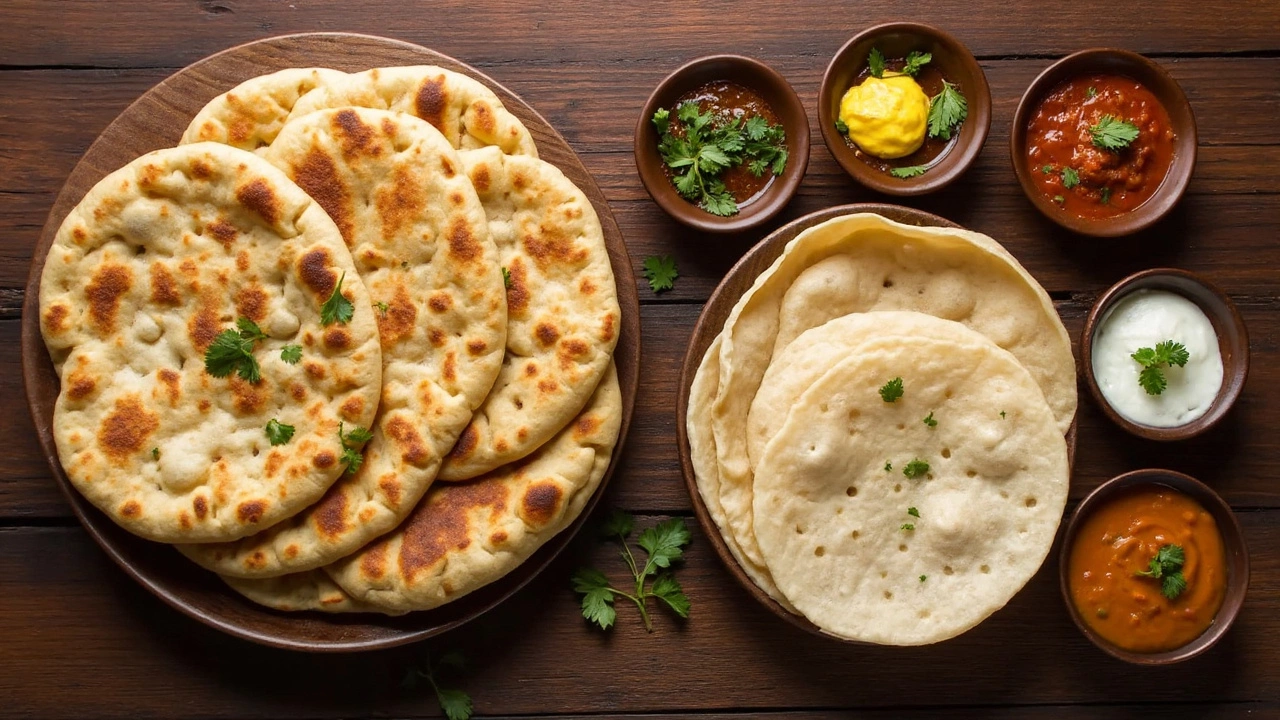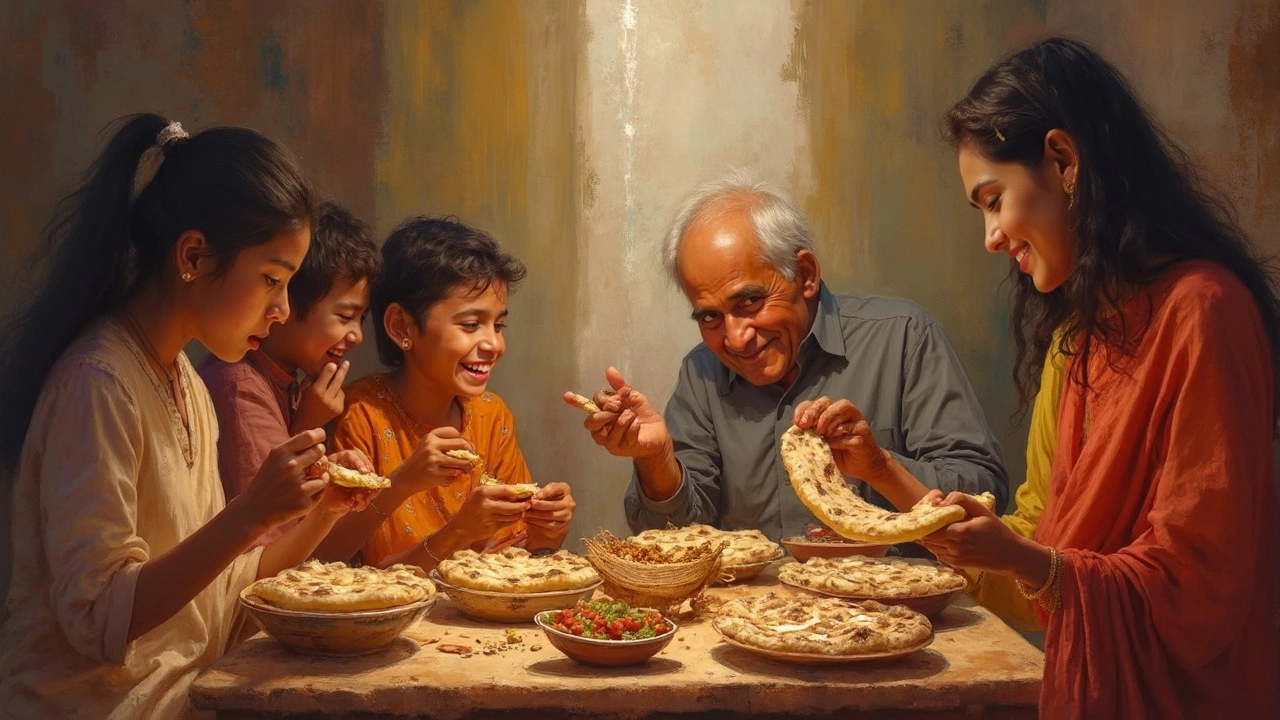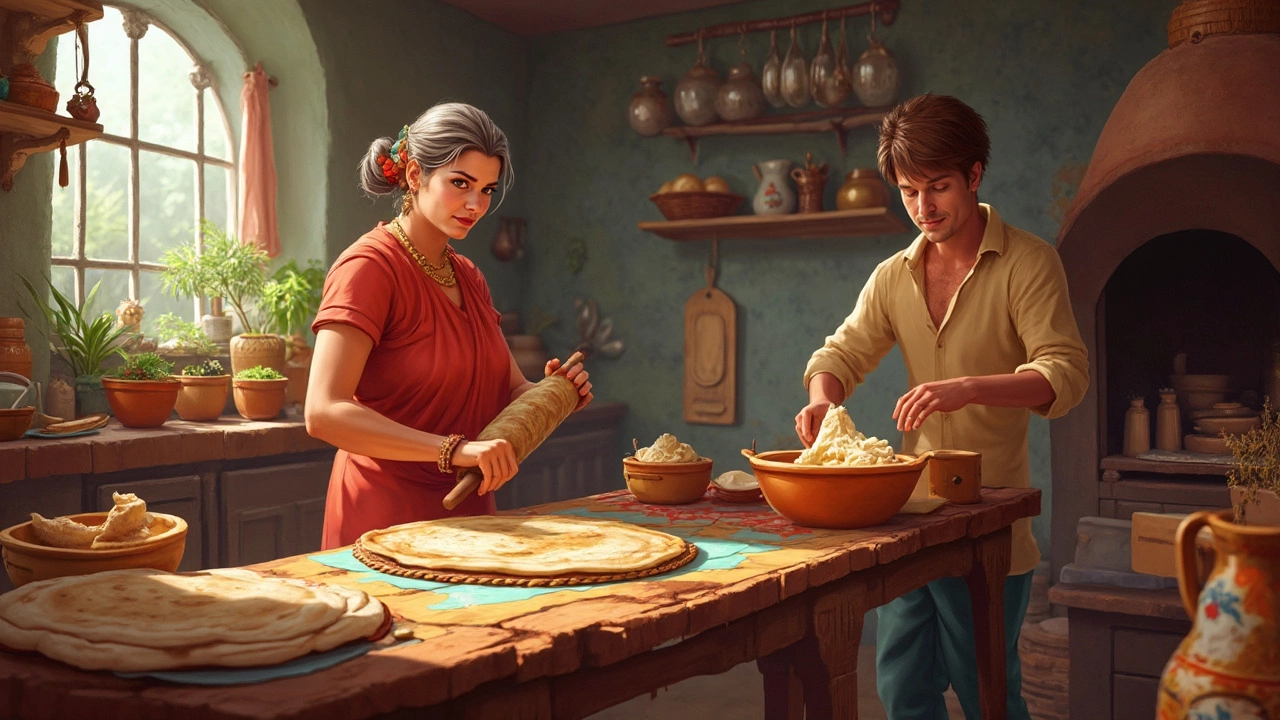Walk into any North Indian restaurant, and you’re smack in the middle of the age-old naan vs. roti debate. Maybe you’ve got friends who argue about which is better—soft, pillowy naan or that perfectly chewy roti stacked right out of a tawa. Order a platter and you’ll realize: they look a bit similar, they both mop up curries, and yet, the experience is completely different. Turns out, it’s not just folklore or someone’s grandmother’s recipe. There are real, interesting differences rooted in history, cooking styles, ingredients, and even how your taste buds will react. Ready to swap confusion for some clear understanding and tips you can use tonight? No need for complicated explanations—just a fresh piece of bread to start tearing into.
Origins and Cultural Significance
Roti and naan aren’t just flatbreads—they basically hold the stories of Indian homes together. Roti goes so far back, historians find references to it in 16th-century Mughal texts. It was born in everyday kitchens, where simplicity ruled and flour, water, and heat were all you needed. Roti is at the heart of Indian villages and small towns, where a stack is always ready at lunchtime. People don’t celebrate with fancy cakes—they break roti together. It stands for sharing, daily life, and home-cooked goodness.
Naan is a different story. Travel north—Punjab, Kashmir, Delhi—and naan makes a grand entrance at feasts, weddings, or any holiday party you can think of. Why? Designed for the royal diners of the Mughals, naan is richer, fluffier, and much more indulgent than its cousin, the roti. The Persians brought the earliest versions through the spice routes. Over time, it became a symbol of luxury in Mughal India, baked in hot tandoors, slathered with ghee or butter, and pulled piping hot from the sides of clay ovens.
Ever notice how naan is nearly always served in restaurants? That’s because home kitchens rarely have those hulking tandoors. Roti, meanwhile, is doable in any setting—you just need a tawa or flat pan. There’s an old joke that if you wake up an Indian mom at midnight and say “guests are here,” she can whip up roti before you finish your sentence. It’s that much a part of the culture.
Even names mean different things. Roti comes from “rotika” in Sanskrit, while “naan” literally just means bread in Persian. The role each plays at the table isn’t just about taste—it’s about region, history, and even class. Back in the day, naan was reserved for royalty and special occasions. In modern India, naan is still “restaurant food”, while roti never left the family kitchen. Just ask anyone from Delhi about their favorite “dhaba” and they’ll order naan, but at home, roti wins every time.
Ingredients: What Really Sets Them Apart?
If you’ve ever tried making naan and roti at home, you’ve probably noticed—one uses all sorts of extras, the other keeps it basic. Roti’s big secret? There’s barely a secret. The standard recipe calls for just two things: atta (whole wheat flour) and water. Once in a while, someone will toss in a pinch of salt, or a bit of ghee, but that’s about it. The dough should be soft—not too dry, not too sticky—because texture is where roti shines. Which is why Indian grocery stores stack “chakki atta” in neatly packed 5kg bags. It’s built for softness and stretch, not for fluff or luxury.
Naan is the opposite—a diva, honestly. You start with white flour (maida), but you’ll also need yogurt or milk, and sometimes eggs. A leavening agent is a must: most home recipes rely on baking powder, but the classic way is with yeast. Sugar helps feed that yeast and brings a hint of sweetness, while ghee, oil, or butter makes each bite rich. That’s why naan is fluffy, a little sweet, with that signature pull that’s almost like pizza crust. Some recipes go wild—black sesame seeds, nigella (kalonji), minced garlic, or even cheese inside for that gooey delight.
Here’s a quick table to see what goes into each flatbread:
| Ingredient | Roti | Naan |
|---|---|---|
| Flour | Whole wheat (atta) | Refined (maida) |
| Main Liquid | Water | Milk/Yogurt/Water mix |
| Leavening | None | Yeast/Baking Powder |
| Fat | Optional ghee | Mandatory (ghee, butter, or oil) |
| Extras | Salt (sometimes) | Sugar, yogurt, eggs (often) |
So when a friend raves about that cloud-like naan at their favorite place, remember, it’s the dough. The magic’s in the mix—not just how you cook it but what you put in from the start. By the way, if you’re vegan or just keeping it simple, roti is much easier—no dairy or eggs to worry about.
Another fun fact: a study published in Food Chemistry found that adding yogurt to naan dough boosts moisture retention and gives it that signature silkiness. The simple combination of maida and yogurt is why naan puffs up instead of staying flat.

Cooking Techniques: Tawa, Tandoor, and Today’s Kitchen
Here’s where your kitchen really matters. Classic roti hardly needs any fancy equipment—just a rolling pin, a flat “tawa” (think a thick skillet with a flat bottom), and an open flame. Roll the dough thin (about as thin as a tortilla) and let it brown on the tawa. Sometimes, you’ll see cooks making “phulka,” which is roti that puffs up over a direct flame, straight from the tawa. Smack it with your hands, and it deflates with a cloud of steam. The smell fills the whole room—and if you’ve made it right, the edges are soft, not crispy.
Naan’s classic home is the tandoor—a giant clay oven heated with coals or wood. Bakers slap dough onto the sides, and the insane heat (sometimes up to 900°F or 482°C) cooks it in seconds, leaving signature brown blisters and a smoky flavor you just can’t fake. Not many folks outside restaurants have a tandoor at home. The workaround? Try a pizza stone in your oven, or use a cast iron skillet on the stove. Some home cooks even stick rolled-out naan dough onto a hot upturned wok to mimic the dome of a tandoor for that charred effect. But, let’s be honest—true tandoor naan is tough to replace.
Wonder what else is different? Roti is rarely brushed with fat—unless you’re making “paratha,” which is another story. Naan, almost always, gets a good rub of butter or ghee right as it comes off the heat. Ask any chef, and they’ll tell you: that last touch is what clinches the flavor.
Curious how long it really takes to bake these in the real world? Here’s a stat that might surprise you: while a tandoor can cook naan in about one minute, the average home oven takes closer to five. That’s a big reason naan stays in restaurants. Plus, the steaming-hot tandoor adds a taste you can’t get from even the fanciest kitchen gadget.
"The tandoor's intense heat not only cooks naan quickly but creates that unmistakable chew and char you crave. That's what puts naan in its own league." ― Madhur Jaffrey, Indian food expert
If you’re just starting out, roti is friendlier. Perfect it first, then move up to naan once you’ve got the confidence (and maybe an oven that cranks up past 500°F!).
Texture, Flavor, and Nutrition: What to Expect on Your Plate
Biting into a fresh roti is an exercise in subtlety. It’s soft but slightly chewy, with just enough bite to stand up to a spicy curry or hearty lentil dal. No one expects roti to steal the show—it’s supposed to complement, not dominate. Texture-wise, think of roti like a tortilla: pliable, thin, perfect for mopping up everything left on your plate. Because it’s made from whole wheat, roti has a very “earthy” taste, not bland but barely sweet.
Naan is a whole different universe. People crave naan for its pillowy texture—a thick outside crust, a soft center, and those slightly charred, crispy bubbles from the tandoor. Richness is what sets naan apart. The yogurt, eggs, and fats in the dough mean every bite melts in your mouth, with a hint of mild sweetness that can sometimes taste almost buttery. Restaurants will play with flavors: garlic naan, cheese naan, even Peshawari naan packed with nuts and dried fruit.
Which is healthier? Here’s the thing: roti packs more fiber, fewer calories, and less fat. Whole wheat’s natural fiber helps with digestion, and there’s barely any sugar or fat unless you slather on ghee (though that’s a guilty pleasure at our table, no lie). Naan tastes amazing but is heavier. With white flour, added fats, and dairy, a single piece of naan can be 250 calories or more—easy. If you want to swap for health reasons, stick with roti for everyday meals and save naan for special nights out or holidays. Here’s how the nutrition breaks down for one average-sized piece (about 40-50 grams):
| Type | Calories | Carbs (g) | Fiber (g) | Protein (g) | Fat (g) |
|---|---|---|---|---|---|
| Naan | 250 | 44 | 1 | 6 | 7 |
| Roti | 100 | 20 | 3 | 3 | 0.5 |
So, if you’re looking to keep things lean, roti’s your daily winner. But nothing beats tearing into a steaming-hot naan when you really want to treat yourself—or impress that friend who thinks they’ve tasted every kind of bread out there.
Flavor and texture tie right back to how they’re cooked and what’s in the dough. That’s why even the best store-bought naan can’t quite match the magic of one made in a blazing-hot tandoor.

Tips for Making Naan and Roti Like a Pro
Ready to try your hand at making these at home? Roti comes first—you’ll get the hang of it by paying attention to dough consistency and rolling thin, round discs (no need to stress about perfect circles, trust me). Here’s how I do it:
- Mix whole wheat flour and water until you get a soft, not sticky dough. Let it rest for 10-15 minutes.
- Divide into golf ball-sized portions and roll flat—aim for about 2mm thickness.
- Cook on a hot tawa, flipping until both sides have golden brown spots. If you want “phulka,” transfer to open flame for a few seconds to puff up.
- Optional: Smear with a little ghee right after for that homey aroma.
Naan is a little more demanding, but it’s not impossible. I save this for weekends when Arjun and I want to go all out.
- Start with maida, add yogurt, milk, a bit of sugar, salt, and leaven with baking powder (or yeast for real authenticity).
- Let the dough rise for at least an hour—it should feel light and airy.
- Roll out, but keep them thicker than roti—you want that bite!
- Add toppings like minced garlic, nigella seeds, or chopped cilantro if you’re feeling adventurous.
- Heat your heaviest cast-iron pan or pizza stone to screaming hot, then cook the naan until bubbles form and the bottom is spotted brown. Flip if needed (or try the upturned-wok trick if you’re brave).
- Brush with melted butter or ghee while still hot for that restaurant finish.
For that extra step? If you have a grill or barbecue, slap naan dough onto the grates—the smoky flavor is the next best thing to a tandoor.
I’ve learned a few tricks along the way: Don’t overwork either dough. Roti dries out fast, so wrap in a kitchen towel the minute they’re cooked. For naan, a splash of milk in the dough keeps them soft, even if you reheat them later. And if you find yourself short on time (or patience), try making small naans—they cook fast, and you get more surface area for butter. If my family’s coming over, I’ll even make garlic naan sticks—easy for dipping and always a crowd-pleaser.
You don’t need any fancy gadgets—just enthusiasm and a willingness to fail and try again (don’t worry, there’s no such thing as a “failed” flatbread, only a taste test opportunity). No matter which one you pick, both naan and roti will turn even the most ordinary dinner into something worth talking about the next day.
